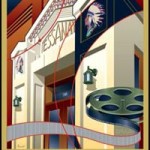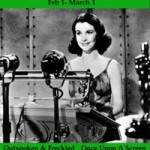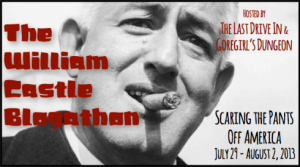The Lonely Man (1957)
It’s been a few months since my last full-length film Western review, so in this month’s column I’m reviewing The Lonely Man (1957), which was just released on Blu-ray by Kino Lorber Studio Classics.

I had no previous familiarity with The Lonely Man, an 88-minute Paramount Pictures film which has an interesting story and a top cast of Western character actors.
Kino Lorber, I’d like to insert here, has done a wonderful job in recent years releasing previously hard-to-find Westerns on Blu-ray, all of which have enriched my Western viewing.
Their releases include Audie Murphy films, a couple of which I’ve reviewed here, and relatively obscure ’50s Westerns such as Man From Del Rio (1956) and The Ride Back (1957), both starring Anthony Quinn. Additional Audie Murphy boxed sets are among the films which have been mentioned as possible future releases.

The Lonely Man has strong echoes of The Gunfighter (1950), as Jacob Wade (Jack Palance) returns home after many years. He left town after being accused of shooting the sheriff, with more killings to his name in the years since, but he hopes to make things right for his wife and son before time runs out.
Jacob learns his wife is dead; his sullen young son Riley (Anthony Perkins) resents him. Undeterred, Jacob wants to set the shiftless Riley up in some sort of business which will give him a secure future. He sets fire to Riley’s run-down shack, and a grudging Riley accompanies his father back on the road.
Jacob looks over a possible livery stable business for Riley in one town, but the Wades are immediately sent on their way by local citizens, and they ultimately end up at the isolated home of Ada (Elaine Aiken). Jacob and Ada had once been lovers, and when he left he gifted her the house.

Jacob, Ada, and Jacob’s old friend Ben (Robert Middleton) go to work capturing wild horses, with Jacob thinking breaking and selling horses might be a good business for Riley.
Right around this time, we learn why Jacob feels such urgency to help his son: He’s going blind. And it doesn’t help matters knowing that old enemies, including King Fisher (Neville Brand), Faro (Lee Van Cleef), and Blackburn (Claude Akins) are in the area, given that his vision woes no longer provide the security of being a fast gun.
I found The Lonely Man imperfect yet worthwhile. Its strengths start with spectacular black and white VistaVision location filming in Lone Pine, California, by Lionel Lindon. Both the movie and the Blu-ray look absolutely fantastic.

The extensive location shooting was of particular interest to me, having spent countless hours in Lone Pine, and those unfamiliar with the area firsthand will nonetheless enjoy its distinctive vistas, including the Alabama Hills and the majestic views of Mount Whitney and Lone Pine Peak.
Other California locations, including Iverson Ranch and Vasquez Rocks, are seen very briefly. The Lonely Man has a definite “A” game in terms of visuals.
Palance is strong is a sympathetic role as the stoic gunslinger. We sense early on that there is more to the man and his story than initially presented. His wordless, beaming delight when Riley finally calls him “Pa” is a highlight of the film.
Palance is surrounded by some of the most menacing baddies in the Western movie business in Brand, Van Cleef, and Akins. Middleton, who often plays villains, is good in a nicely rounded role as Jacob’s flawed yet loyal pal. Middleton has a particularly strong scene when he finally gives Riley the facts on why his father left town years ago and seemingly abandoned his mother.

The movie also boasts appearances from a host of great character actors, including Elisha Cook Jr., James Bell, John Doucette, Russell Simpson, Tudor Owen, and Denver Pyle.
The performances from Perkins and Aiken are unfortunately less stellar. Perkins is fairly colorless and wooden as the conflicted son — much the same as I found him in the same year’s The Tin Star (1957). He’s simply a placeholder as Riley, in a role which cries out for a more sympathetic and appealing performance.
Aiken, who was appearing in her first film and has an “introducing” card in the opening credits, seems too mannered and theatrical compared to Palance’s natural performance. Her line deliveries at times are quite stilted, especially in her first reunion scene with Palance.
After watching the film I learned Aiken had studied with Lee Strasberg and later cofounded New York’s Actors Conservatory in the ’80s, and that seems to perhaps explain the “staginess” of her performance, along with her lack of screen experience. After The Lonely Man she had only a handful of film and TV roles, spread over many years. She passed on in 1998.

Perkins and Aiken shared an underdeveloped romantic relationship late in the film; it comes as a surprise, given her continued devotion to Jacob. That was a misstep in the script by Harry Essex and Robert Smith, nor was it convincingly acted.
The Lonely Man was directed by Henry Levin, one of a small number of Westerns he directed over his long career. Other Levin Westerns included The Man From Colorado (1948) with Glenn Ford and William Holden and the semi-Western The Gambler From Natchez (1954) with Rory Calhoun and Debra Paget.
I was surprised to realize that I’ve seen a very significant number of Levin’s films, most of which aren’t considered classics as such, yet are consistently entertaining. Levin favorites include The Bandit of Sherwood Forest (1946) with Cornel Wilde and Anita Louise and The Mating of Millie (1948) with Glenn Ford and Evelyn Keyes.
The score for The Lonely Man was by Van Cleave, with the theme song by Van Cleave and Jack Brooks, sung by Tennessee Ernie Ford. I was also interested to note, per IMDb, that famed guitarist Laurindo Almeida was heard on the soundtrack.

Kino Lorber’s Blu-ray is from a new HD master from Paramount, from a 6K scan of the 35mm original VistaVision camera negative. It’s truly beautiful and one of the reasons to check out this disc. Sound quality is also excellent.
Kino Lorber has presented The Lonely Man as a special edition with a cardboard slipcase. Disc extras include the trailer; a gallery of five trailers for other Westerns available from Kino Lorber; and a commentary track by Western movie expert Toby Roan.
While a somewhat dark storyline and a pair of weak supporting performances disappointed, on the whole I enjoyed viewing this new-to-me Western completely “cold.” I found quite a bit to like, including most of the cast and the gorgeous views. I suspect fellow Western fans will also find it worth checking out, particularly given the excellent presentation by Kino Lorber Studio Classics.
If any of this column’s readers would like to share thoughts on this movie, please feel welcome to do so in the comments!
Thanks to Kino Lorber for providing a review copy of this Blu-ray.
…
– Laura Grieve for Classic Movie Hub
Laura can be found at her blog, Laura’s Miscellaneous Musings, where she’s been writing about movies since 2005, and on Twitter at @LaurasMiscMovie. A lifelong film fan, Laura loves the classics including Disney, Film Noir, Musicals, and Westerns. She regularly covers Southern California classic film festivals. Laura will scribe on all things western at the ‘Western RoundUp’ for CMH.






















































Laura, a good write-up of THE LONELY MAN(filmed 1956, released 1957), which I think is a thinking person’s Western and I think it’s worth viewing. I would rather view this well acted and rather calm performance by Jack Palance than most of the tripe put out today. I enjoyed the really good ensemble cast of the movie and I probably like this movie more than you, but it’s no forgotten masterpiece. If my memory serves me right, I first viewed this movie on Little Rock, Arkansas’ KARK Channel 4 Saturday afternoon movie in the early 1970’s.
Like you, I’ve viewed several movies directed by Henry Levin. My favorite is JOURNEY TO THE CENTER OF THE EARTH(1959), which I first viewed on THE ABC WEDNSEDAY NIGHT MOVIE in 1967.
I look forward to your next write-up.
I knew Pat Duggan, the producer reasonably well in the sixties. At that time this civilized man could not get a project off the ground. All of his Paramount films had merit, none of them were box office magic. Although We’re No Angels scored in the top forty of its year. Not good but not disgraceful either.
Barry, was it the movie adaption of Willi Heinrich’s CROSS OF IRON(1956) that Pat Duggan couldn’t get off the ground? Robert Stack was to be in the movie about German soldiers on the Russian Front during World War II. The movie was to be filmed in the Black Forest of Germany and realism was to be stressed.
Walter, the answer is yes, there was also a second project by
Robert Ruark, a sequel to Something of Value.
Further comment:
Walter, you are really sharp which I expect you to be, but pulling a failed project or a forgotten producer out of the air rates a salute.
Pat produced The Search for Bridey Murphy at Paramount with Louis and Teresa Wright. it was a career killer. Nevertheless, Hayward introduced me to Duggan and as we were both living in New York it was realistic, but nothing much happened.
Barry, thank you for the kind words. I’ve been blessed with a good memory for most of my life, although it’s not as good as it used to be. Anyway, when I’m reading sometimes a name, calendar date, place, or happening will trigger my memory. So, when you wrote that you knew Pat Duggan the producer in the 1960’s and that he couldn’t get a project off the ground, that triggered my memory. Sometime ago I was digging around in information concerning the World War II movie CROSS OF IRON(filmed 1976, released 1977), which was directed by Sam Peckinpah. West German producer Wolf C. Hartwig had got the project going, where a failed attempt had been made with Robert Stack in the 1960’s. Stack was to play Sargeant Steiner. I did a search and found an article from 1963, where Robert Stack was talking about his next movie CROSS OF IRON, which was to be filmed in Germany. The producer was Pat Duggan and Stack said that Duggan stressed realism. The movie was never made.
You mentioned a second project that Duggan couldn’t get off the ground a sequel to SOMETHING OF VALUE(filmed 1956, released 1957) taken from Robert Ruark’s UHURU(1962). I know nothing about this proposed sequel, but about 4 weeks ago I was at the humane society, and they have a thrift store to raise money for the animals’ food and care. I was looking through the used book section and I found Robert Ruark’s SOMETHING OF VALUE(1955). A person just never knows.
Barry, I always enjoy it when you reminisce.
Right back at you, Walter. I missed you when you were away, and so did many others.
Since I actually like Anthony Perkins’s turn in The Tin Star, I think I should try to find this western! Jack Palance in a rare non-villainous role is always a treat, too. And with Neville Brand, Lee Van Cleef, and Claude Aikens as the baddies? Plus, I’m so fond of Elisha Cook, Jr. Yeah, I need to get a copy of this. Thanks for bringing it to my attention, Laura!